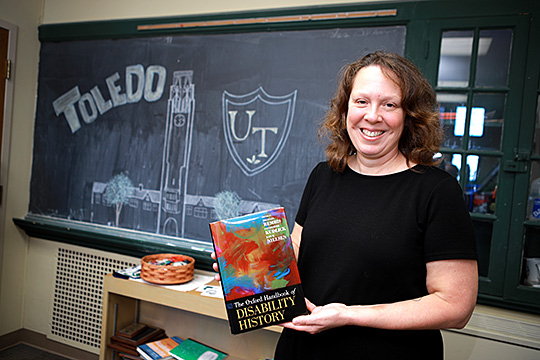A pioneering professor of disability studies at The University of Toledo is an editor and contributor to “The Oxford Handbook of Disability History.”
Dr. Kim Nielsen, who helped launch the first undergraduate degree of its kind in disability studies in the country at UT, is one of three editors of the book published by Oxford University Press and one of 30 experts to write a chapter.

Dr. Kim Nielsen is one of three editors of the “The Oxford Handbook of Disability History” and one of 30 experts to write a chapter.
The cover of the book was designed by a group of artists who work together at Shared Lives Studio in downtown Toledo.
“We wanted meaningful, quality art done by a person or persons with disabilities, and we found it,” Nielsen said. “Their work is beautiful.”
Nielsen’s co-editor Dr. Michael Rembis, associate professor in the Department of History and director of the Center for Disability Studies at the University at Buffalo, will host a public lecture at UT titled “A Fact Was No Less a Fact Because It Was Told by a Crazy Person” Wednesday, Oct. 17, at 4 p.m. in Carlson Library Room 1005.
“Dr. Rembis is a skilled historian and storyteller whose work can help us better understand today’s mental health practices and helps us remember that people considered mentally ill also live lives with family, labor, community institutions and day-to-day interactions,” Nielsen said. “This scholarship should be of interest to all interested in public health policies, disability, history, psychology and social change.”
In the introduction to the new book, the editors wrote, “By its very nature, an Oxford Handbook offers legitimacy to disability history, an indication of the field’s growing import.”
Nielsen’s book chapter is titled “The Perils and Promises of Disability Biography.”
“Telling the life story of someone whose life included disability, unpacking the relationship between that individual life and its larger historical context, and analyzing the questions and insights raised by that life have much to offer scholars and readers,” Nielsen wrote.
“A disability analysis does not simply mean discerning whether or not historical subjects have a disability, just as a gender or racial analysis does not simply mean discerning the race or sex of historical subjects. A disability approach analyzes the role of ableism — built structures and social systems that favor the nondisabled — in shaping relationships, systems of power, ideals, disparagements, and the multiple ways of being in the world.”
Nielsen fights back against the common narrative of disability in the Western world that an individual overcomes or “triumphs over the calamity of disability.”
She uses President Franklin Roosevelt as an example showing that his life reveals the embedded nature of disability.
“From the time he was first affected by polio as a young adult to his death while in his fourth term as the U.S. president, the wealthy son of a prestigious New York family was aided by an extensive network of individuals willing to help him pass as nondisabled,” Nielsen wrote. “The FDR that most of us know and admire today was made possible by an intimate network of support; an American public that variably denied, ignored or was ignorant of his disability; and historians who followed that path.”
Nielsen also discusses the use of primary sources, the opportunities to analyze previously unconsidered sources, and reconsidering the imbalanced power dynamics used to create and archive historical sources.
“For example, many, if not all, of the photographs of Millie and Christine McKoy, conjoined twins born into slavery in 1851, made under the guise of science, were sexually exploitive, coerced and sensationalistic,” Nielsen wrote. “Many people with disabilities live and have lived in times and spaces where they have no recognized right or access to privacy.”
As a historian who is not disabled, Nielsen opens up about the importance of visiting places central to individuals who were overlooked or hidden away from society, such as her visit to the grave of the subject of her current biographical project, Dr. Anna Ott, a white female physician who died in 1893 after being determined legally incompetent and institutionalized for 20 years in a state insane asylum as a patient of one of her former male colleagues.
Of the 771 people buried at the “nearly unmarked cemetery” over a nearly 100-year period, Nielsen said, “Only eight of the dead had the privilege of grave markers. The rest lay unnamed and largely unclaimed. The disregard with which they had been treated in death revealed much about their lives.”
Nielsen also said that disability biography can be about nondisabled subjects, such as Frances Perkins, who “served as secretary of labor in the Franklin Roosevelt administration, while simultaneously mothering a daughter, providing exclusive financial support for her household, and caring for/managing her frequently institutionalized husband.”
“Perkins was not disabled, but disability permeated her life,” Nielsen wrote.
Nielson’s most recent book, “A Disability History of the United States,” was published by Beacon Press in 2012.